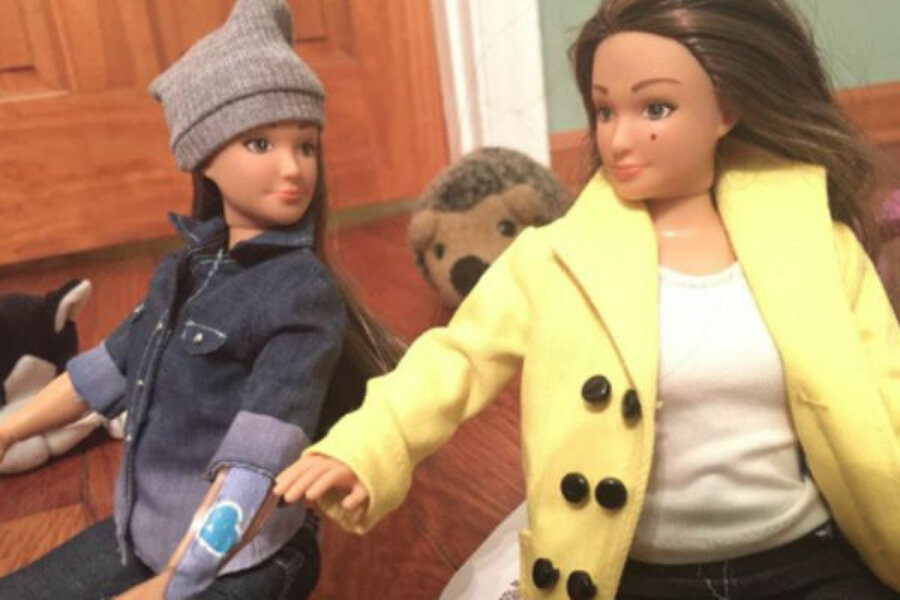Lammily on sale: How 'Average Barbie' could unseat more popular dolls this holiday
Loading...
There’s a new doll in town, Lammily, who wants little girls to know “It’s time to get real” by ditching the ill-proportioned skinny girl idolatry in favor of embracing average proportions, cellulite, and other realistic physical attributes.
Lammily (lammily.com), popularly referred to as “the average Barbie” when it was introduced months ago, went on sale Wednesday, just in time for holiday shoppers.
The doll was made possible via crowdfunding campaign launched by inventor Nickolay Lamm of Pittsburgh, Pennsylvania.
According to the original crowd funding site where Mr. Lamm raised more than $500,000, the Lammily doll bodies are based on measurements listed on the website for the Centers for Disease Control for the average 19-year-old woman.
“People think ‘Oh you raised all that money you don’t need to even sell the doll’ but the truth is every penny went into making the very best doll I could possibly make,” Lamm says in a phone interview.
“Basically, I’m broke right now, but very happy with the results.”
The doll sells for $25 and has not only a selection of wardrobe pieces, but also stickers sold for an additional $5.99 per pack that allow kids to add scars, stitches, cellulite, and tattoos to their dolls.
Lamm first made headlines in May 2013, by helping Barbie and other dolls take it all off – their makeup that is – in a series of photoshopped images he and a friend generated in order to show that the dolls looked lovely without the war paint.
In a new promotional video, Lamm once again uses his image editing skills only this time on a realistically proportioned Lammily doll with minimal makeup which he morphs into a taller, leaner, better endowed Barbie doll. He then reverses the process to transform the doll into the more normally proportioned Lammily with the slogan “It’s time to get real” as the kicker.
“Until today there was no doll on the market which is affordable and which is made according to realistic body proportions,” Lamm wrote in an email. “Many people criticize Barbie and there was no alternative. Now, I’ve made one – Lammily – and when little girls see her, hold her, they feel like they already know her because she is more like them and the people they know.”
Lamm said he has been play-testing the doll with children locally over the past month and brought the finished dolls to St. Edmund's Academy, an independent day school in Pittsburgh for kids in preschool - 8th grade. He visited with second graders to see how they would react to the doll and captured their response in a video.
I found it hard not to tear-up watching the video of the little girls at St. Edmunds as, one after another, girls of various races took the doll from the box and said lovingly, “She looks like my sister.”
“It’s unique,” one girl says in a way that tells the viewer she has not been coached or had her words chopped into sound bites. “Because I don’t have other dolls like this. It looks real.”
The real revelation in the video comes about half way in when the kids are asked what career Lammily (while the doll is dressed in a bikini) might have and the answers include: teacher, swimmer, and computer job.
Then the kids are given a Barbie, also in a bikini and asked what her career options might be and the kids responded: surfer, fashion store, model, and makeup artist. One little girl looks at Barbie appraisingly and concludes, “It doesn’t look like she does any job.”
The girls also point out that Lammily looks as if her feet would actually support her body in real life whereas Barbie has “tippy toes” that “looks like she has invisible heels on.”
While there appears to have been a fairly balanced number of boys to girls who tested the dolls, only one boy’s comments were highlighted in the video, which seems to be mainly geared toward a female market.
A boy who has also been assessing the dolls comes to the conclusions that Barbie “looks like more fashiony, like she thinks she’s better than everybody else.”
In the end, given a choice of which doll they would like as a present, the students all chose Lammily, stating that they already have Barbies and don’t need more of the same.
Even the boy says that when the boy versions come out (something that has not been discussed by Lamm, but is apparently expected by this child) he would play with his all the time.
One new doll on the market may not create an immediate, sweeping change in the market, or alter the skewed body image perceptions many kids have about themselves and others. But watching the very genuine affection the girls seem to feel toward a doll they have just been handed is a beautiful start to a friendship that may blossom into more of us loving who we are when we look in the mirror.








